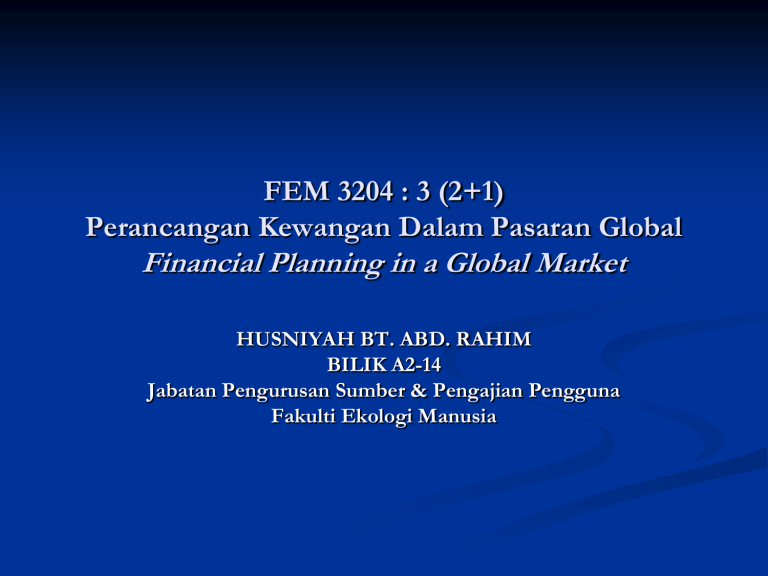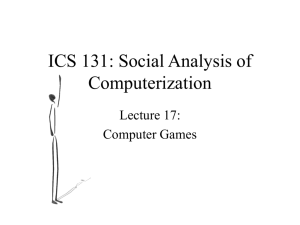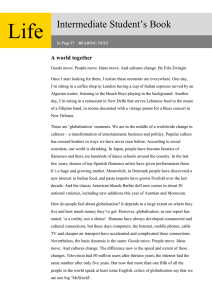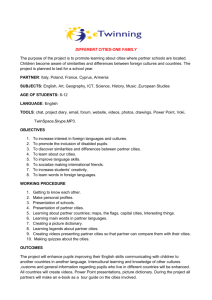Global Marketing

FEM 3204 : 3 (2+1)
Perancangan Kewangan Dalam Pasaran Global
Financial Planning in a Global Market
HUSNIYAH BT. ABD. RAHIM
BILIK A2-14
Jabatan Pengurusan Sumber & Pengajian Pengguna
Fakulti Ekologi Manusia
Chapter 9
Analysis of the Strategic Global
Marketing Approach and the
Effect on Individuals Financial
Behavior
Global Marketing
It refers to marketing activities coordinated & integrated across multiple country markets (Johansson,
2000)
Global marketing & international marketing has a slight difference with global marketing a broader marketing compared to international marketing
Global marketing is an extension of international marketing
Global Marketing
A global approach is used to international marketing.
What are being focused by managers are on the product markets, that is, groups of customers seeking shared benefits or to be served with the same technology, emphasizing their similarities regardless of geographic areas in which they are located
They should not be focusing on country markets, that is, the differences due to the physical location of customers groups
Global Marketing
Global marketing is the process of conceptualizing & conveying a final product or services worldwide hoping to reach the international marketing community
With proper global marketing, it can enable to eleviate a company to the next level,
Need different strategies based on the region the company is marketing to
Global Marketing
The operation mode is very different from marketing locally
Organisations begin to develop and run operations in the targeted country or countries outside of the domestic one
In practice, organisations evolve from domestic to global enterprises
It involves 4 stages of change & the characteristics of companies at different stages in the process of evolving from domestic to global enterprises are different as follows:.
Global Marketing
1. Stage one:
Focus on domestic, all activity concentrated in the home market.
Many organisations can survive doing business domestically, but may bring to long term failure.
2. Stage two:
Home focus, but with exports.
Rely in home values, but creates an export division
Global Marketing
3. Stage three:
Stage two organisations which realise that they must adapt their marketing mixes to overseas operations.
The focus switches to multinational & more on adaption
4. Stage four:
Global organisations create value by extending products
& programmes, & focus on serving emerging global markets
They have to recognise that markets around the world consist of similarities & differences
Global Marketing
Thus, for stage 4, it is possible to develop a global strategy based on similarities to obtain scale economies, but also recognises & responds to cost effective differences.
Its strategies are a combination of extension, adaptation
& creation
Unpredictable in behaviour & should always alert to opportunities
Global Marketing
In planning to do global marketing, must consider the following:
A number of environmental factors
Generally the company should be looking for
"unifying" or "differentiating" influences that will dictate a "standard or "adapted" planning approach
Demographic factors of the locals in each country: income, age; purchasing power
Global Marketing: Orientation of
Management
Based on Perlmutter (1967): There are 4 orientations of management of global/international organisations.
Named as the "EPRG" scheme
Associated with successive stages in the evolution of international operations
1.
2.
Ethnocentrism : home country orientation - exporting surplus
Polycentrism : host country orientation - subsidiary operation (international)
Global Marketing: Orientation of
Management
3. Regiocentrism: regional orientation - world market strategies (multinational)
4. Geocentrism: world orientation - world market strategies (global)
Number 3 & 4 are based on
similarities & differences in markets capitalising on similarities to obtain cost benefits, but still recognising differences
Global Marketing: Theoretical
Approaches
Theory of comparative advantage (Adam Smith &
David Ricardo), the product trade cycle (Raymond
Vernon), & The Business Orientation (Howard
Perlmutter)
The theory of comparative advantage: is a demonstration (under assumptions) that a country can benefit from trade even if it has an absolute disadvantage in the production of all goods, or it can gain from trade even if it has an absolute advantage in the production of all goods.
Global Marketing: Theoretical
Approaches
Even though a country has an absolute production advantage it may be better to concentrate on its comparative advantage.
To maximise the wellbeing of both individuals and countries, countries are better off specialising in their area of competitive advantage and then trading and exchanging with others in the market place.
Global Marketing: Financial Products
Covers financial products marketing across three different continents - US, UK, & China
Marketing of financial products in the US focuses on banking, insurance, & credit cards
The banking system in the US has undergone a transformation over the years & maturing
Expanded their business into other financial services, other than bank & branch.
Many banks in the US make a shift from depending on fund-based products to fee-based services.
Global Marketing: Financial Products
Pricing of credit cards has also evolved over the years with changes in pricing policies & computational methods
Ethnic groups in the US form a major customer segment for insurance marketers.
Marketers have tailored the communication patterns to appeal to these groups & this approach has increased the profit
Global Marketing: Financial Products
Worksite marketing has also shown tremendous growth, especially for insurance products
Most financial products in the future will continue to be marketed through this channel
Among the three broad categories of pension plans, only about 20 percent of the workforce opts for individual retirement accounts
Global Marketing: Financial Products
Mutual fund marketers use extensively online advertising.
In the UK, the banking sector has adopted technologies to monitor/ understand customer behavior, that would alert staff to the customer needs & also help devise methods to improve delivery of services.
In life insurance pricing, lifestyle-linked obesity risk has been used as premium determination
However, the preferred lives concept has not been very successful due to operational difficulties
Global Marketing: Financial Products
IFAs (Independent Financial Advisors) have gained prominence as a new channel of distribution for a majority of financial products like life insurance, pension, & mutual funds
A recent development in the UK. Is the emergence of fund supermarkets
These are like grocery stores where a wide variety of funds are available for the customers at one place
The fees levied are lower compared to dealing directly with a fund house due to the large number of mutual fund products that the fund house sells.
Global Marketing: Financial Products
The Chinese financial services industry is a major target destination for global financial players
The magnitude of foreign investments is huge in the
Chinese banking sector, especially in retail banking & vehicle financing.
Another attractive segment for global players is the consumer credit market, which includes credit cards, loans, & mortgages
The mutual funds sector is undergoing a major change with commercial banks being allowed to deal with mutual funds.
Global Marketing: Cultures
Important issue facing marketers is the extent to which one or more global consumer cultures or segments are emerging
There are proofs to the movement in this direction
This kind of culture would have a shared set of consumption-related symbols, with common meaning & desirability among members
One example of global culture is that portion of local cultures that view themselves as cosmopolitan,* knowledgeable, and modern.
* international in scope: having worldwide relevance or scope
Global Marketing: Cultures
These individuals share many values & consumptionrelated behaviors with similar individuals across a range of national cultures
Such cultures are created by the globalisation of mass media, work, education,and travel
Global Marketing: Globalisation of
Financial Product
Advances in communication & technology together with financial deregulation abroad (eg. Lifting of regulatory structures that inhibit competition & protect domestic markets ) have diminished the distinction between domestic & foreign financial markets
With necessary technology & reduced cost of transaction, the world has become one interconnected market
Global Marketing: Globalisation of
Financial Product
Markets for government securities and certain stocks, foreign exchange trading, interbank borrowing & lending operate continuously 24 hours around the world & in enormous size
This result in a big competition among key financial centers & financial institution that helps to reduce costs of issuing new securities
Global Marketing: Globalisation of
Financial Product
This growing competition led to increasing of deregulation of financial markets worldwide whereby users of capital markets will issue & trade securities in financial market with the lowest regulatory standard, lowest costs.
Treasurers no longer confined to domestic markets as the source of funding & are quick to exploit any attractive opportunity occurs elsewhere in the world
Global Marketing: Globalisation of
Financial Product
The competition drives the international financial system
It further result in financial innovation that segments, transfers and diversifies risk
Enables companies to tap previously inaccessible markets & permits investors & issuers to take advantage of tax loopholes
International capital mobility has increased tremendously





